Socio-Hydrological Modelling to Assess Reliability of an Urban Water System under Formal-Informal Supply Dynamics
Abstract
1. Introduction
2. Modelling Approach
2.1. Feedback Loops
2.2. System Components and Model Building
2.2.1. Formal System Water Balance Sector
2.2.2. Infrastructure Condition Sector
2.2.3. Consumer Behaviour
2.2.4. Formal System Fund Balance
2.3. Data and Sources
2.4. Model Scope, Assumptions, Calibration and Validation
2.5. Sensitivity Analysis
3. Results
3.1. Urban Water Demand Growth and Formal Water Sector Balance
3.2. Formal–Informal Demand Shift and the Feedbacks
3.3. Fund Balance
3.4. Sensitivity Analysis
4. Discussion
5. Conclusions
Supplementary Materials
Author Contributions
Funding
Acknowledgments
Conflicts of Interest
References
- Kooy, M. Developing informality: The production of Jakarta’s urban waterscape. Water Altern. 2014, 7, 35–53. [Google Scholar]
- Majuru, B.; Suhrcke, M.; Hunter, P.R. How do households respond to unreliable water supplies? A systematic review. Int. J. Environ. Res. Public Health 2016, 13, 1222. [Google Scholar] [CrossRef] [PubMed]
- Pattanayak, S.K.; Yang, J.-C.; Whittington, D.; Bal Kumar, K.C. Coping with unreliable public water supplies: Averting expenditures by households in Kathmandu, Nepal. Water Resour. Res. 2005, 41. [Google Scholar] [CrossRef]
- Walter, C.T.; Kooy, M.; Prabaharyaka, I. The role of bottled drinking water in achieving SDG 6.1: An analysis of affordability and equity from Jakarta, Indonesia. J. Water Sanit. Hyg. Dev. 2017, 7, 642–650. [Google Scholar] [CrossRef]
- Onda, K.; LoBuglio, J.; Bartram, J. Global access to safe water: Accounting for water quality and the resulting impact on MDG progress. Int. J. Environ. Res. Public Health 2012, 9, 880–894. [Google Scholar] [CrossRef] [PubMed]
- Vásquez, W.F. Willingness to pay and willingness to work for improvements of municipal and community-managed water services. Water Resour. Res. 2014, 50, 8002–8014. [Google Scholar] [CrossRef]
- Prakash, A. The periurban water security problem: A case study of Hyderabad in Southern India. Water Policy 2014, 16, 454–469. [Google Scholar] [CrossRef]
- Rehan, R.; Knight, M.A.; Haas, C.T.; Unger, A.J. Application of system dynamics for developing financially self-sustaining management policies for water and wastewater systems. Water Res. 2011, 45, 4737–4750. [Google Scholar] [CrossRef]
- Peloso, M.; Morinville, C. Chasing for water: Everyday practices of water access in peri-urban Ashaiman, Ghana. Water Altern. 2014, 7, 121–139. [Google Scholar]
- Enouy, R.; Rehan, R.; Brisley, N.; Unger, A. An implicit model for water rate setting within municipal utilities. J. Am. Water Work. Assoc. 2015, 107, e445–e453. [Google Scholar] [CrossRef]
- Srinivasan, V.; Seto, K.C.; Emerson, R.; Gorelick, S.M. The impact of urbanization on water vulnerability: A coupled human–environment system approach for Chennai, India. Glob. Environ. Chang. 2013, 23, 229–239. [Google Scholar] [CrossRef]
- Gupta, H. An integrated Modeling and Decision Tool for Improved Drinking Water Reliability in Rural Villages of India; Massachusetts Institute of Technology: Cambridge, MA, USA, 2015. [Google Scholar]
- Imad, H.U. Consumer’s Willingness to Pay for Municipally Supplied Water: A Case Study of Hyderabad City; Mehran University of Engineering and Technology: Jamshoro, Pakistan, 2017. [Google Scholar]
- Blair, P. Novel Modelling Approaches and Data Sources in Socio-Hydrology; Imperial College London: London, UK, 2018. [Google Scholar]
- Sivapalan, M.; Savenije, H.H.G.; Blöschl, G. Socio-hydrology: A new science of people and water. Hydrol. Process. 2012, 26, 1270–1276. [Google Scholar] [CrossRef]
- Elsawah, S.; Pierce, S.A.; Hamilton, S.H.; van Delden, H.; Haase, D.; Elmahdi, A.; Jakeman, A.J. An overview of the system dynamics process for integrated modelling of socio-ecological systems: Lessons on good modelling practice from five case studies. Environ. Model. Softw. 2017, 93, 127–145. [Google Scholar] [CrossRef]
- Sivapalan, M.; Blöschl, G. Time scale interactions and the coevolution of humans and water. Water Resour. Res. 2015, 51, 6988–7022. [Google Scholar] [CrossRef]
- Rehan, R.; Knight, M.A.; Unger, A.J.; Haas, C.T. Development of a system dynamics model for financially sustainable management of municipal watermain networks. Water Res. 2013, 47, 7184–7205. [Google Scholar] [CrossRef]
- Rehan, R.; Unger, A.; Knight, M.A.; Haas, C. Strategic water utility management and financial planning using a new system dynamics tool. J. Am. Water Work. Assoc. 2015, 107, e22–e36. [Google Scholar] [CrossRef]
- Furlong, K.; Kooy, M. Worlding water supply: Thinking beyond the network in Jakarta. Int. J. Urban Reg. Res. 2017, 41, 888–903. [Google Scholar] [CrossRef]
- Wutich, A.; Beresford, M.; Carvajal, C. Can informal water vendors deliver on the promise of a human right to water? Results from Cochabamba, Bolivia. World Dev. 2016, 79, 14–24. [Google Scholar] [CrossRef]
- Nganyanyuka, K.; Martinez, J.; Wesselink, A.; Lungo, J.H.; Georgiadou, Y. Accessing water services in Dar es Salaam: Are we counting what counts? Habitat Int. 2014, 44, 358–366. [Google Scholar] [CrossRef]
- Miraftab, F. Insurgent planning: Situating radical planning in the Global South. Plan. Theory 2009, 8, 32–50. [Google Scholar] [CrossRef]
- Gleick, P.H.; Cain, N.L. The World’s Water 2004–2005: The Biennial Report on Freshwater Resources; Island Press: Washington, DC, USA, 2004. [Google Scholar]
- Srinivasan, V. Reimagining the past—Use of counterfactual trajectories in socio-hydrological modelling: The case of Chennai, India. Hydrol. Earth Syst. Sci. 2015, 19, 785–801. [Google Scholar] [CrossRef]
- Sterman, J. Business Dynamics: System Thinking and Modeling for a Complex World Irwin McGraw-Hill; Massachusetts Institute of Technology, Engineering Systems Division: Cambridge, MA, USA, 2000. [Google Scholar]
- Ahmad, S.; Ali, S.; Mirza, M.; Lotia, H. The limits of water pricing in a developing country metropolis: Empirical lessons from an industrial city of Pakistan. Water 2017, 9, 533. [Google Scholar] [CrossRef]
- Kalhoro, M.I. Report of Commission of Inquiry; Supreme Court of Pakistan: Islamabad, Pakistan, 2017; p. 157. [Google Scholar]
- Zaidi, S.F.Z. Identifying Sustainability Indicators’ Metrics for Safe Water Services: A Case Study of Hyderabad City; Mehran University of Engineering and Technology: Jamshoro, Pakistan, 2017. [Google Scholar]
- Srinivasan, V.; Gorelick, S.M.; Goulder, L. Factors determining informal tanker water markets in Chennai, India. Water Int. 2010, 35, 254–269. [Google Scholar] [CrossRef]
- Planning and Development Department (P&D) Sindh Pakistan. Annual Development Program. Available online: https://pnd.sindh.gov.pk/annual-development-programs (accessed on 12 August 2020).
- United Nations Development Programme Pakistan. Water security in Pakistan: Issues and challenges. Dev. Advocate Pak. 2016, 3, 1–39. [Google Scholar]
- Nauges, C.; Whittington, D. Estimation of water demand in developing countries: An overview. World Bank Res. Obs. 2009, 25, 263–294. [Google Scholar] [CrossRef]
- Reynaud, A.; Romano, G. Advances in the economic analysis of residential water use: An introduction. Water 2018, 10, 1162. [Google Scholar] [CrossRef]
- Pakistan Bureau of Statistics. Budgetary Position of Households by Income and Quintiles 2015–16; Technical report No. HIES 2015-16; Pakistan Bureau of Statistics: Islamabad, Pakistan, 2016. [Google Scholar]
- Irrigation Department, Government of Sindh Pakistan. Upstream Water Flow at Kotri Barrage, Sindh Pakistan 1998–2018; Irrigation Department, Government of Sindh Pakistan: Karachi, Pakistan, 2018. [Google Scholar] [CrossRef]
- Government of Pakistan. National Drinking Water Policy Draft; Ministry of Environment, Government of Pakistan: Islamabad, Pakistan, 2009; p. 13. [Google Scholar]
- Hyderabad Getting Turbid Water. Available online: https://www.dawn.com/news/738462 (accessed on 3 August 2020).
- Li, B.; Sivapalan, M.; Xu, X. An Urban sociohydrologic model for exploration of Beijing’s water sustainability challenges and solution spaces. Water Resour. Res. 2019, 55, 5918–5940. [Google Scholar] [CrossRef]
- Srinivasan, V.; Gorelick, S.M.; Goulder, L. A hydrologic-economic modeling approach for analysis of urban water supply dynamics in Chennai, India. Water Resour. Res. 2010, 46. [Google Scholar] [CrossRef]
- Pakistan Bureau of Statistics. District and tehsil level population summary with region breakup for Hyderabad District, Sindh. In Census 2017; Pakistan Bureau of Statistics: Islamabad, Pakistan, 2017. [Google Scholar]
- ISEE Systems. Sensitivity Analysis. Available online: https://www.iseesystems.com/resources/help/v1-9/default.htm#05-Running_Models/Sensitivity_analysis/Overview_Sensitivity_analysis.htm?Highlight=sensitivity%20analysis (accessed on 12 July 2020).
- Subbaraman, R.; Shitole, S.; Shitole, T.; Sawant, K.; O’Brien, J.; Bloom, D.E.; Deshmukh, A.P. The social ecology of water in a Mumbai slum: Failures in water quality, quantity, and reliability. BMC Public Health 2013, 13, 1–14. [Google Scholar] [CrossRef]
- Hunter, P.R.; MacDonald, A.M.; Carter, R.C. Water supply and health. PLoS Med. 2010, 7, e1000361. [Google Scholar] [CrossRef]
- Amir, P.; Habib, Z. Act Report Estimating the Impacts of Climate Change on Sectoral Water Demand in Pakistan; Action on Climate Today: Islamabad, Pakistan, 2015; p. 107. [Google Scholar]
- Burt, Z.; Ray, I. Storage and non-payment: Persistent informalities within the formal water supply of Hubli-Dharwad, India. Water Altern. 2014, 7, 106–120. [Google Scholar]
- Pakistan Bottled Water Market: Growth Trends and Forecast 2020–2025. Available online: https://www.mordorintelligence.com/industry-reports/pakistan-bottled-water-market (accessed on 18 May 2019).
- Pakistan Bureau of Statistics. Pakistan Social and Living Standards Measurement Survey (2014-15); Government of Pakistan Statistics Division: Islamabad, Pakistan, 2016; p. 489. [Google Scholar]
- Pakistan Bureau of Statistics. Percentage Distribution of Monthly Consumption Expenditure per Households by Commodity Groups and Quintiles, 2015-16; Pakistan Bureau of Statistics: Islamabad, Pakistan, 2016. [Google Scholar]
- Kujinga, K.; Vanderpost, C.; Mmopelwa, G.; Wolski, P. An analysis of factors contributing to household water security problems and threats in different settlement categories of Ngamiland, Botswana. Phys. Chem. Earth Parts A/B/C 2014, 67, 187–201. [Google Scholar] [CrossRef]
- Hassan, A. City Running Dry. Available online: https://www.dawn.com/news/1434849/city-running-dry (accessed on 25 September 2019).
- Hyderabad Water Crisis Deepens. Available online: https://www.dawn.com/news/757653/newspaper/newspaper/column (accessed on 26 October 2019).
- Water Crisis Persists in Hyderabad. Available online: https://www.dawn.com/news/775296/water-crisis-persists-in-hyderabad (accessed on 2 January 2020).
- Power Supply Suspended: Water Crisis in Hyderabad as Standoff Continues. Available online: https://tribune.com.pk/story/700009/power-supply-suspended-water-crisis-in-hyderabad-as-standoff-continues (accessed on 25 April 2020).
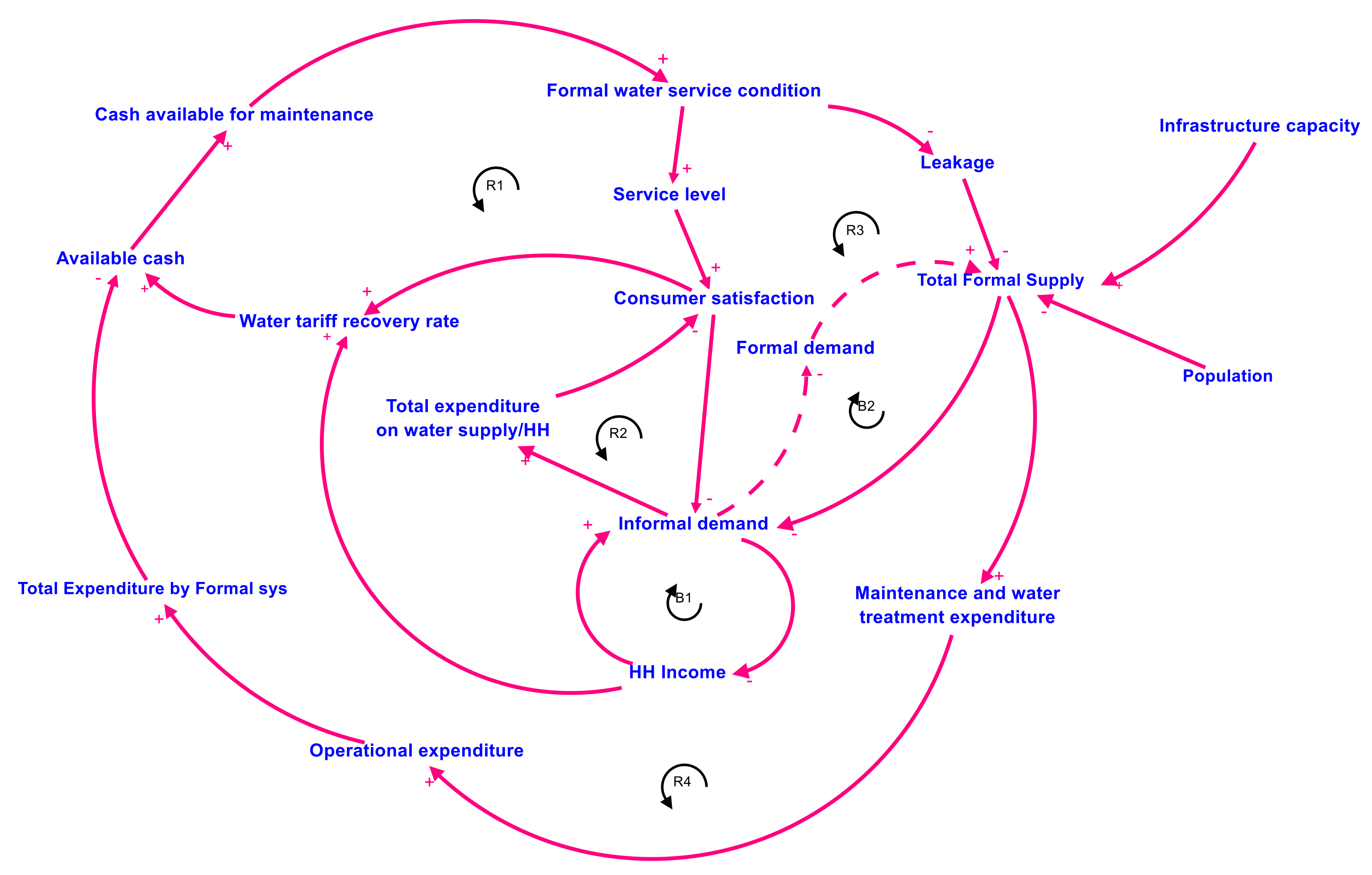
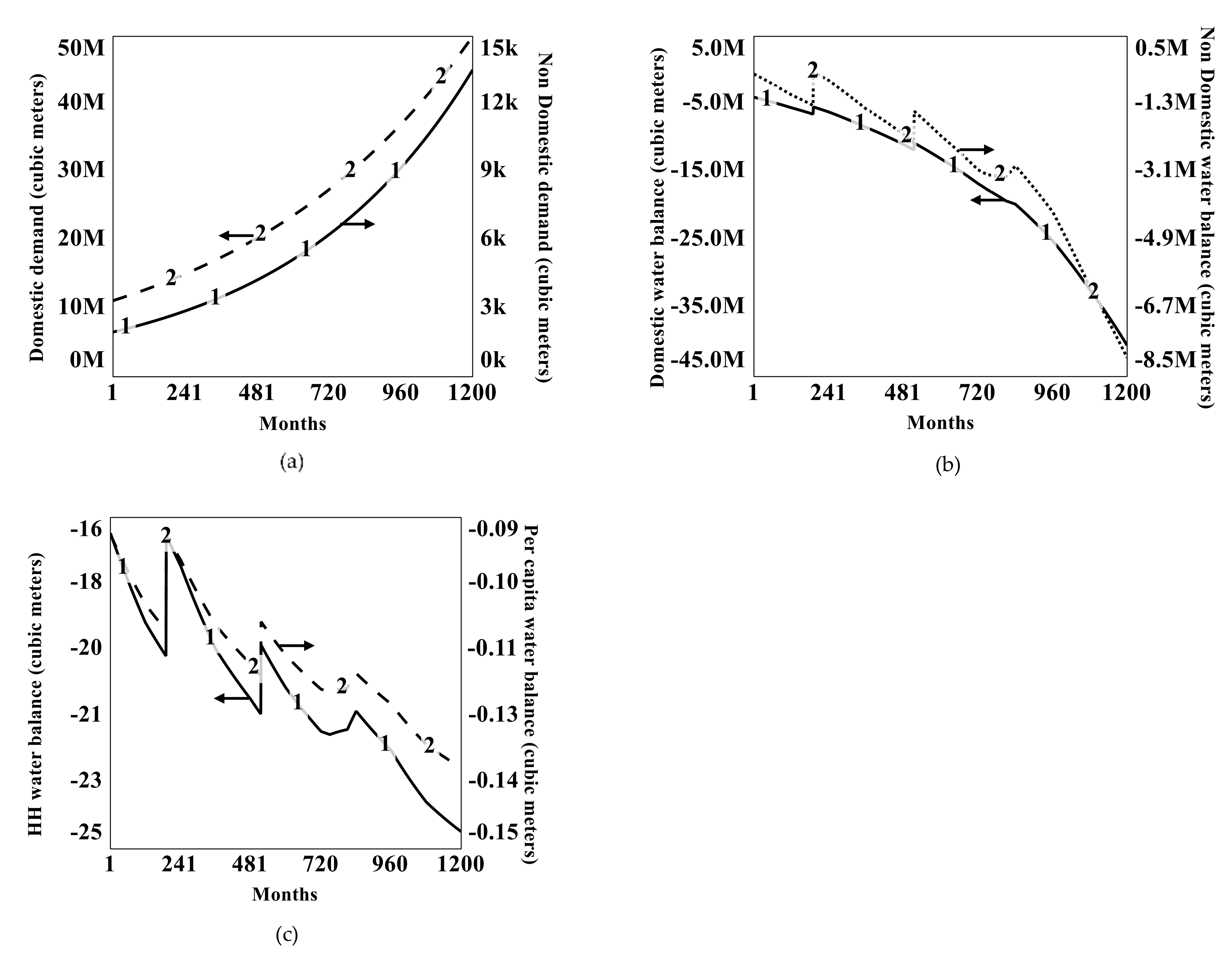
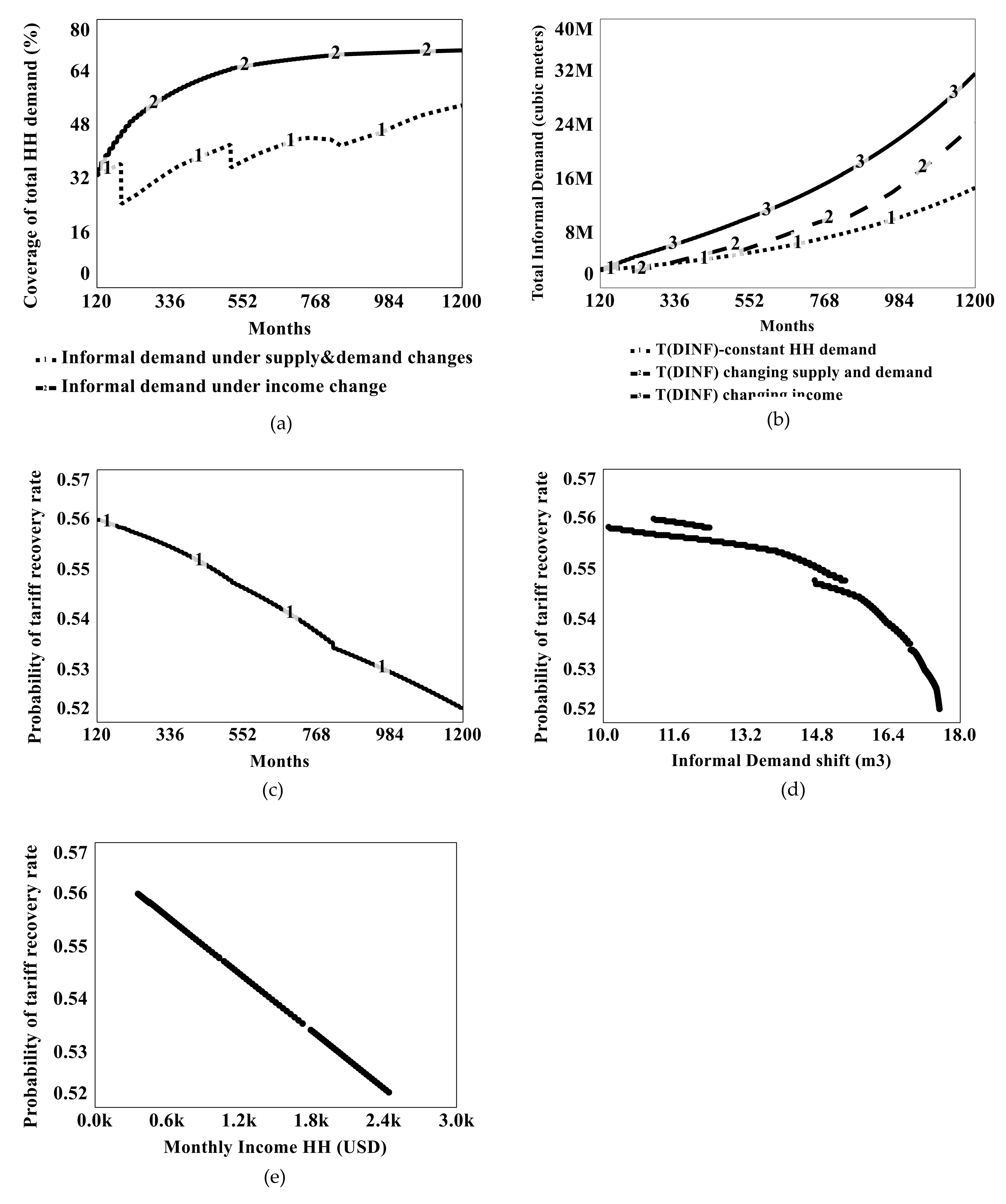
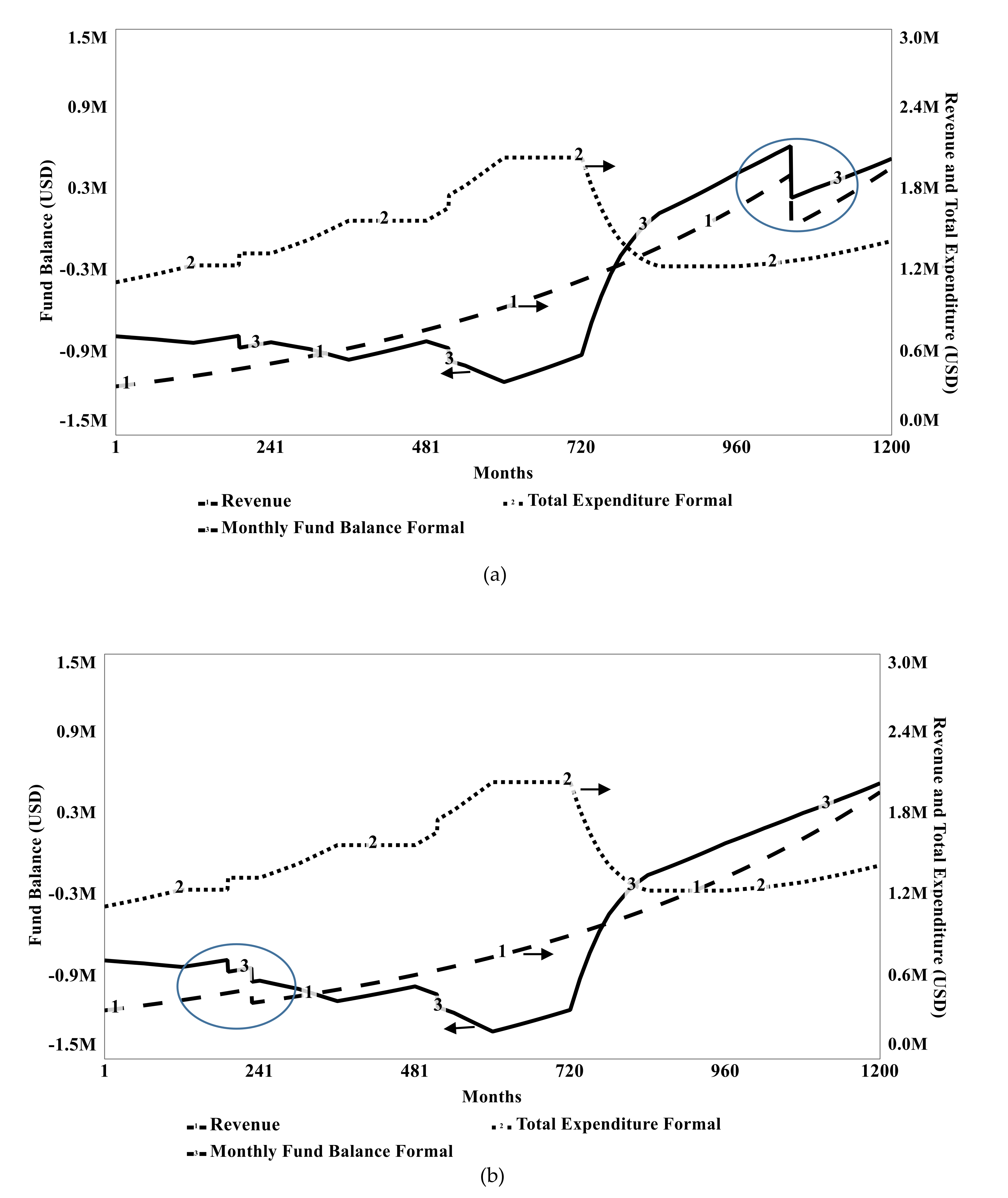
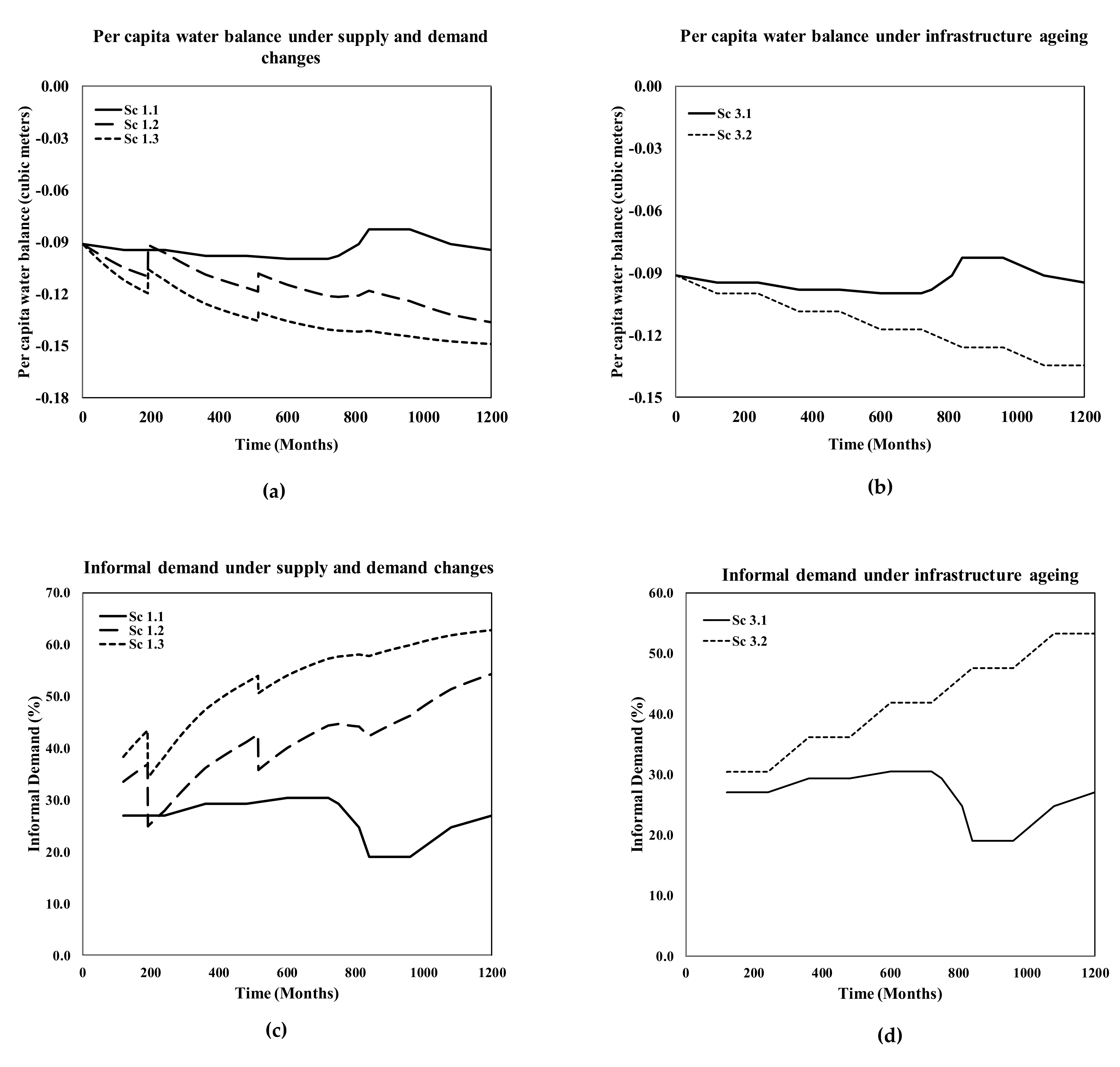
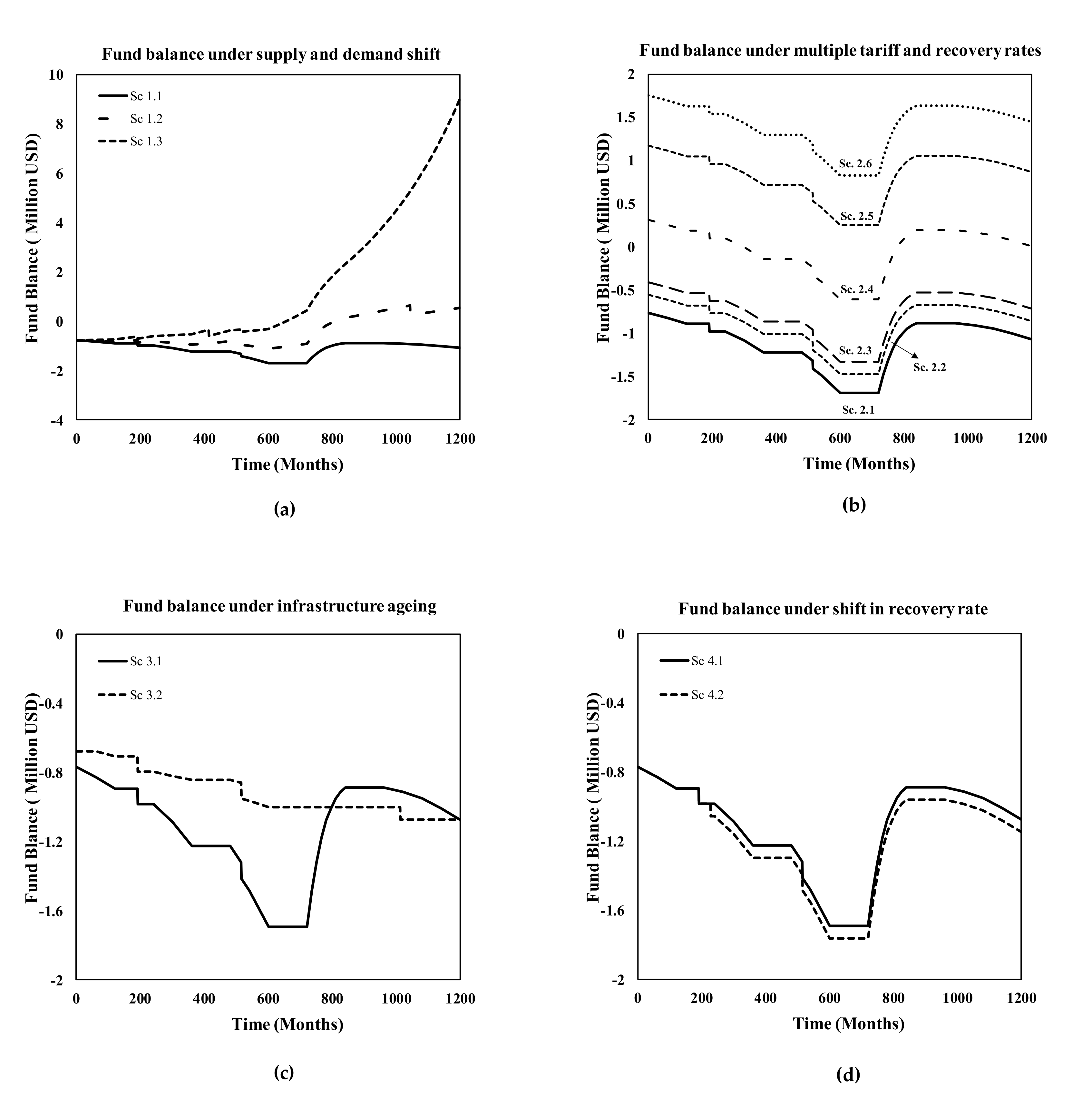
| Scenario | GRD (%) | GRND (%) | ST (MCM/Month) | Water Tariff (USD/Month) | Tariff Recovery Rate (%) | System Losses (%) | OpEx (Condition Multiplier) | Change in Recovery Rate (%) |
|---|---|---|---|---|---|---|---|---|
| 1.1 | 0 | 0 | 6.8 | 3 | 0.5 | 30–40 | Condition multiplier 1 (Figure S5d) | 0 |
| 1.2 | 1.94 | 1.5 | t1 = 6.8, t192 = 9.8, t512 = 12.8 | 3 | 0.5 | 30–40 | 0 | |
| 1.3 | 3.6 | 1.5 | t1 = 6.8, t192 = 9.8, t512 = 12.8 | 3 | 0.5 | 30–40 | 0 | |
| 2.1 | 0 | 0 | 6.8 | 3 | 0.5 | 30–40 | 0 | |
| 2.2 | 0 | 0 | 6.8 | 3 | 0.8 | 30–40 | 0 | |
| 2.3 | 0 | 0 | 6.8 | 3 | 1.0 | 30–40 | 0 | |
| 2.4 | 0 | 0 | 6.8 | 12 | 0.5 | 30–40 | 0 | |
| 2.5 | 0 | 0 | 6.8 | 12 | 0.8 | 30–40 | 0 | |
| 2.6 | 0 | 0 | 6.8 | 12 | 1.0 | 30–40 | 0 | |
| 3.1 | 0 | 0 | 6.8 | 3 | 0.5 | 30–40 | Condition multiplier 1 (Figure S5d) | 0 |
| 3.2 | 0 | 0 | 6.8 | 3 | 0.5 | 30–80 | Condition multiplier 2 (Figure S5d) | 0 |
| 4.1 | 0 | 0 | 6.8 | 3 | 0.5 | 30–40 | Condition multiplier 1 (Figure S5d) | 0 |
| 4.2 | 0 | 0 | 6.8 | 3 | 0.5 | 30–40 | −10 |
© 2020 by the authors. Licensee MDPI, Basel, Switzerland. This article is an open access article distributed under the terms and conditions of the Creative Commons Attribution (CC BY) license (http://creativecommons.org/licenses/by/4.0/).
Share and Cite
Bano, R.; Khiadani, M.; Burian, S. Socio-Hydrological Modelling to Assess Reliability of an Urban Water System under Formal-Informal Supply Dynamics. Water 2020, 12, 2795. https://doi.org/10.3390/w12102795
Bano R, Khiadani M, Burian S. Socio-Hydrological Modelling to Assess Reliability of an Urban Water System under Formal-Informal Supply Dynamics. Water. 2020; 12(10):2795. https://doi.org/10.3390/w12102795
Chicago/Turabian StyleBano, Rakhshinda, Mehdi Khiadani, and Steven Burian. 2020. "Socio-Hydrological Modelling to Assess Reliability of an Urban Water System under Formal-Informal Supply Dynamics" Water 12, no. 10: 2795. https://doi.org/10.3390/w12102795
APA StyleBano, R., Khiadani, M., & Burian, S. (2020). Socio-Hydrological Modelling to Assess Reliability of an Urban Water System under Formal-Informal Supply Dynamics. Water, 12(10), 2795. https://doi.org/10.3390/w12102795







